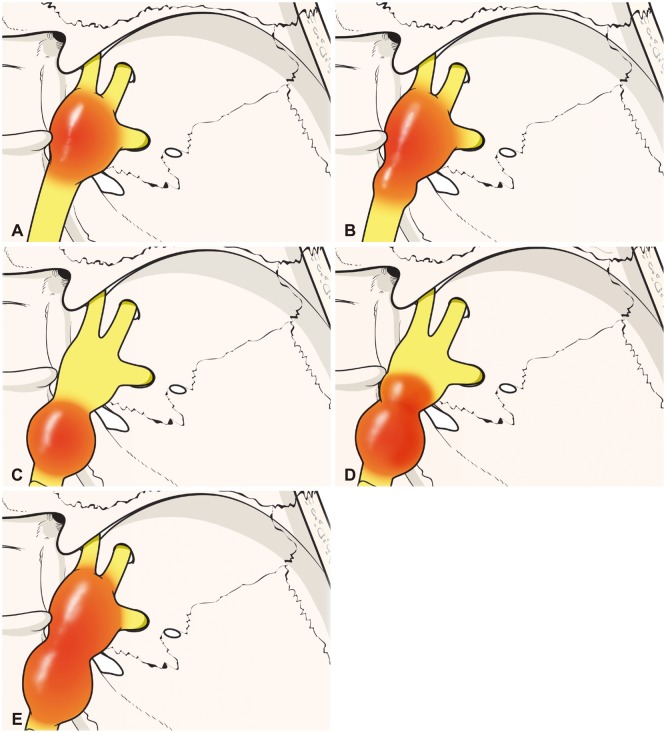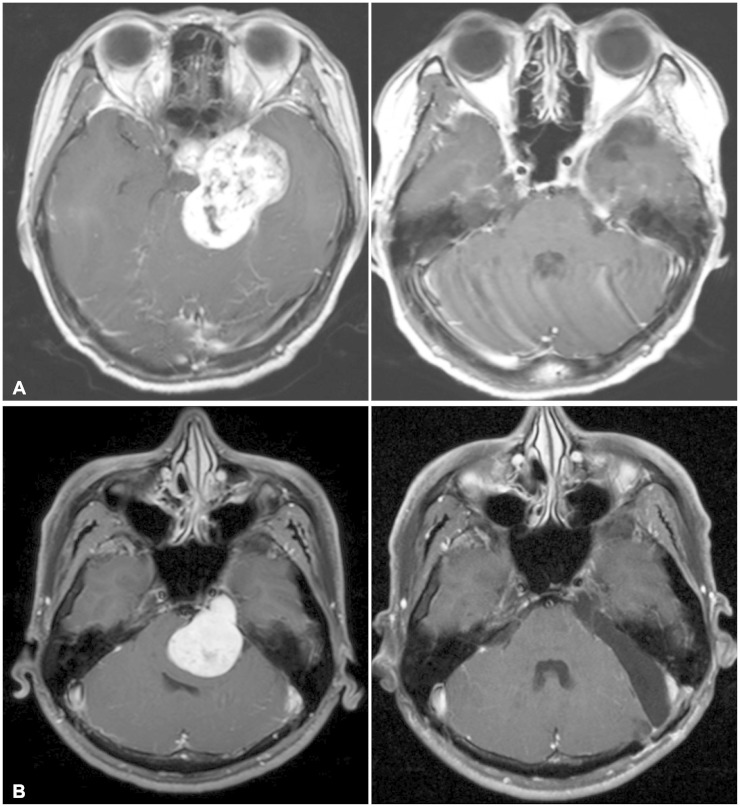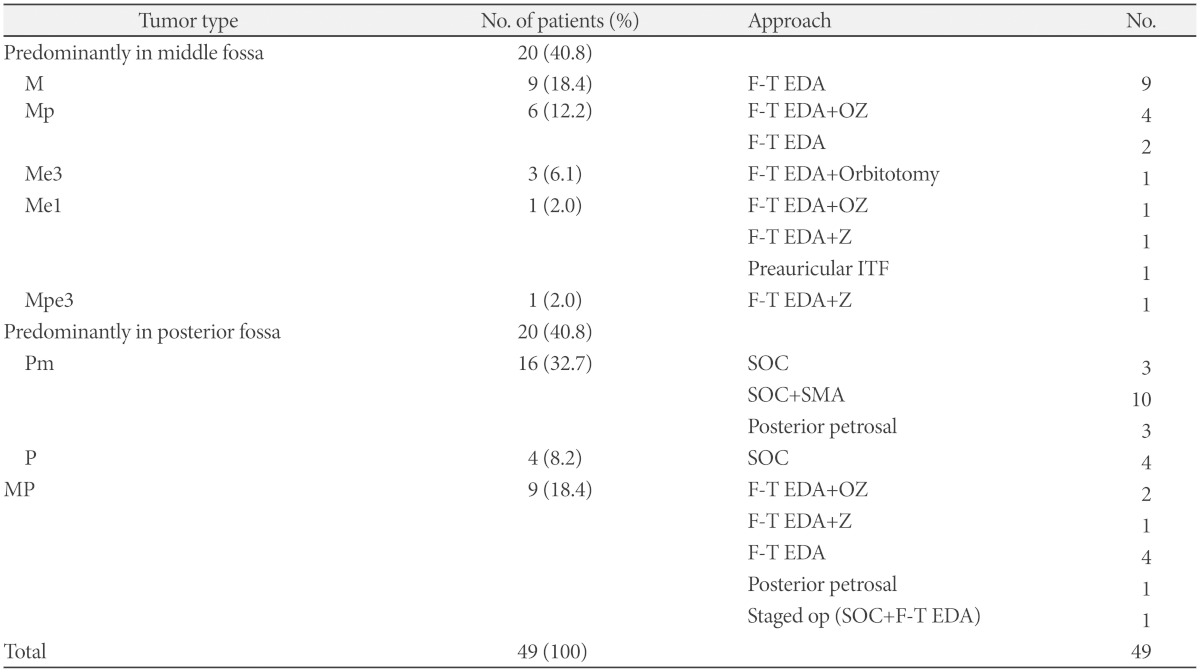1. Fukaya R, Yoshida K, Ohira T, Kawase T. Trigeminal schwannomas: experience with 57 cases and a review of the literature. Neurosurg Rev. 2010; 34:159–171. PMID:
20963463.

2. Goel A, Shah A, Muzumdar D, Nadkarni T, Chagla A. Trigeminal neurinomas with extracranial extension: analysis of 28 surgically treated cases. J Neurosurg. 2010; 113:1079–1084. PMID:
19895193.

3. Liu XD, Xu QW, Che XM, Yang DL. Trigeminal neurinomas: clinical features and surgical experience in 84 patients. Neurosurg Rev. 2009; 32:435–444. PMID:
19633876.

4. Wanibuchi M, Fukushima T, Zomordi AR, Nonaka Y, Friedman AH. Trigeminal schwannomas: skull base approaches and operative results in 105 patients. Neurosurgery. 2012; 70(1 Suppl Operative):132–143. discussion 143-4. PMID:
21796003.

5. Zhang L, Yang Y, Xu S, Wang J, Liu Y, Zhu S. Trigeminal schwannomas: a report of 42 cases and review of the relevant surgical approaches. Clin Neurol Neurosurg. 2009; 111:261–269. PMID:
19081670.

6. Pollack IF, Sekhar LN, Jannetta PJ, Janecka IP. Neurilemomas of the trigeminal nerve. J Neurosurg. 1989; 70:737–745. PMID:
2709114.
7. Jefferson G. The trigeminal neurinomas with some remarks on malignant invasion of the gasserian ganglion. Clin Neurosurg. 1953; 1:11–54. PMID:
14379464.

8. Goel A, Muzumdar D, Raman C. Trigeminal neuroma: analysis of surgical experience with 73 cases. Neurosurgery. 2003; 52:783–790. discussion 790. PMID:
12657173.

9. Guthikonda B, Theodosopoulos PV, van Loveren H, Tew JM Jr, Pensak ML. Evolution in the assessment and management of trigeminal schwannoma. Laryngoscope. 2008; 118:195–203. PMID:
18090871.

10. Samii M, Migliori MM, Tatagiba M, Babu R. Surgical treatment of trigeminal schwannomas. J Neurosurg. 1995; 82:711–718. PMID:
7714594.

11. Lesoin F, Rousseaux M, Villette L, et al. Neurinomas of the trigeminal nerve. Acta Neurochir (Wien). 1986; 82:118–122. PMID:
3491493.

12. Yoshida K, Kawase T. Trigeminal neurinomas extending into multiple fossae: surgical methods and review of the literature. J Neurosurg. 1999; 91:202–211. PMID:
10433308.

13. Al-Mefty O, Ayoubi S, Gaber E. Trigeminal schwannomas: removal of dumbbell-shaped tumors through the expanded Meckel cave and outcomes of cranial nerve function. J Neurosurg. 2002; 96:453–463. PMID:
11883829.

14. Taha JM, Tew JM Jr, van Loveren HR, Keller JT, el-Kalliny M. Comparison of conventional and skull base surgical approaches for the excision of trigeminal neurinomas. J Neurosurg. 1995; 82:719–725. PMID:
7714595.

15. Dolenc VV. Frontotemporal epidural approach to trigeminal neurinomas. Acta Neurochir (Wien). 1994; 130:55–65. PMID:
7725943.

16. McCormick PC, Bello JA, Post KD. Trigeminal schwannoma. Surgical series of 14 cases with review of the literature. J Neurosurg. 1988; 69:850–860. PMID:
3057125.
17. Hasegawa T, Kida Y, Yoshimoto M, Koike J. Trigeminal schwannomas: results of gamma knife surgery in 37 cases. J Neurosurg. 2007; 106:18–23. PMID:
17236483.

18. Pamir MN, Peker S, Bayrakli F, Kiliç T, Ozek MM. Surgical treatment of trigeminal schwannomas. Neurosurg Rev. 2007; 30:329–337. discussion 337. PMID:
17676346.

19. Yasui T, Hakuba A, Kim SH, Nishimura S. Trigeminal neurinomas: operative approach in eight cases. J Neurosurg. 1989; 71:506–511. PMID:
2795170.

20. Schisano G, Olivecrona H. Neurinomas of the Gasserian ganglion and trigeminal root. J Neurosurg. 1960; 17:306–322. PMID:
14442838.

21. Konovalov AN, Spallone A, Mukhamedjanov DJ, Tcherekajev VA, Makhmudov UB. Trigeminal neurinomas. A series of 111 surgical cases from a single institution. Acta Neurochir (Wien). 1996; 138:1027–1035. PMID:
8911538.

22. Day JD, Fukushima T. The surgical management of trigeminal neuromas. Neurosurgery. 1998; 42:233–240. discussion 240-1. PMID:
9482173.

23. Sarma S, Sekhar LN, Schessel DA. Nonvestibular schwannomas of the brain: a 7-year experience. Neurosurgery. 2002; 50:437–448. discussion 438-9. PMID:
11841710.

24. Bordi L, Compton J, Symon L. Trigeminal neuroma. A report of eleven cases. Surg Neurol. 1989; 31:272–276. PMID:
2928920.
25. Phi JH, Paek SH, Chung HT, et al. Gamma Knife surgery and trigeminal schwannoma: is it possible to preserve cranial nerve function? J Neurosurg. 2007; 107:727–732. PMID:
17937215.

26. MacNally SP, Rutherford SA, Ramsden RT, Evans DG, King AT. Trigeminal schwannomas. Br J Neurosurg. 2008; 22:729–738. PMID:
19085355.









 PDF
PDF ePub
ePub Citation
Citation Print
Print


 XML Download
XML Download